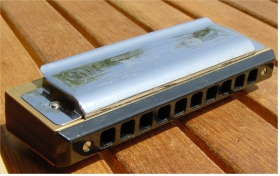 |
High Notes on the XB-40 by Rick Epping, the XB-40 designer
The range of notes easily obtainable on an XB-40 is determined
at its upper limit by the resonant frequency of the highest
chambers relative to the resonant frequency of the reeds occupying
those chambers. The smaller the air space within a reed chamber,
the higher its resonant frequency will be and the higher pitched
will be the reed that can be effectively played there. The chambers
in the highest holes of the XB-40 have been designed as small
as possible given the clearance requirements for the reeds and
valves as well as the requirements of the injection molding
process by which the comb is manufactured.
Difficulty begins to arise with the XB-40 keys of C and
higher, when the resonant frequency of the reeds in Hole 10
exceeds that of their chamber and the lower frequency of the
chamber begins to pull the oscillating frequency of the reeds
downward in a phenomenon known as mode locking or frequency
pulling. The greater the disparity between the higher frequency
of a reed and the lower frequency of its chamber, the more difficulty
there will be in obtaining good performance. It is for this
reason that the key range for the XB-40, like that of the chromatics,
is set lower than that of the standard, single-reed diatonics
(C/C# is the highest chromatic key while high G is the highest
diatonic key). The highest reed in a Hohner Richter 10-hole
model, the g4 reed from Hole 10 of a high G harp, would play
flat and with some difficulty if set over a Model 270 or 280
chromatic's highest chamber, which is larger and has a lower
resonant frequency than that of a Hole 10 Richter chamber. The
difficulty would be greater still were that same reed set over
the highest chamber of an XB-40, which is actually a double
chamber - the inner valve chamber combined with either the upper
blow reed chamber or the lower draw reed chamber, depending
on the direction of airflow. While the Hole 10 reeds in the
lower XB-40 keys play easily, those in the highest few keys
play with some difficulty as their resonant frequency is higher
than the resonant frequency of the Hole 10 double chamber.
Technique can to some extent minimize this problem. For
high notes on harmonicas with small reed chambers, the player's
tongue can be positioned either forward in the mouth to create
a resonant frequency in the reed chamber/mouth cavity matching
that of the reed being played or down and back in the mouth
to avail of the higher partials of the full vocal tract. On
the higher keys of the XB-40 however, the player might not be
able to position the tongue forward enough to reach the resonant
frequency of the reed being played, resulting in an unintentional
bend or a choked note. If the tongue is instead positioned back
in the mouth to create a fundamental resonant frequency one
octave lower than that of the reed, the second partial of this
larger mouth cavity will then match that of the reed and allow
it to play. From this position the tongue can be shifted upward
and forward for a bend. Using this technique, the reeds in Hole
10 on an XB-40 in the key of C are playable though relatively
stiff compared to the reeds in the lower holes due to their
exceeding the resonant frequency of their reed chamber.
In conclusion, while the reeds in Hole 10 on the lower keys
of the XB-40 are quite playable they are less easily so for
the key of C where their frequency is somewhat higher than that
of the reed cell. By the highest key of Eb, the reeds in Hole
10 may be effectively beyond the range of practical playability.
While adjustment of technique can extend the range of playable
high notes, it should be recognized that this range is limited
in the highest keys of XB-40, where the highest reeds are pitched
well above the resonant frequency of their reed chamber.
|